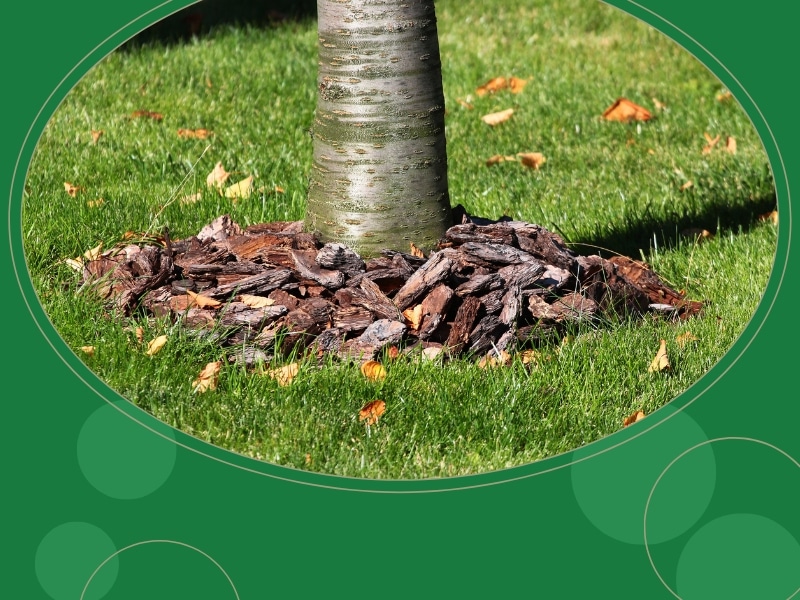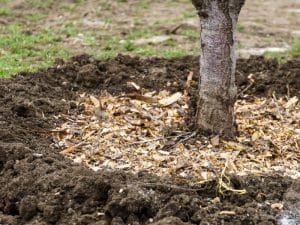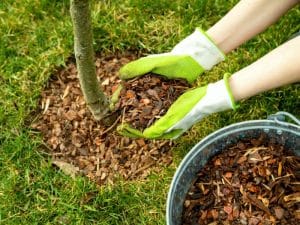Mulching is more than just an aesthetic choice; it’s a crucial practice for promoting tree health and sustainability. Whether you’re nurturing a majestic oak or a delicate fruit tree, mulching can significantly enhance their growth and resilience. This guide explores why mulch around trees is essential for their overall well-being.
What is mulching, and why is it essential for trees?
Mulch is a layer of material, typically organic matter like wood chips, bark, or shredded leaves, spread around the base of a tree. It acts like a protective blanket, offering a multitude of benefits for your tree’s health:
- Moisture retention: Mulch helps reduce water evaporation from the soil, especially during Melbourne’s hot summers. This means less frequent watering for you and a happy, hydrated tree!
- Weed suppression: Mulching effectively controls weeds around trees by creating a barrier that blocks sunlight and prevents weed seeds from germinating.
- Temperature regulation: Mulch acts as an insulator, keeping the soil around the tree’s roots cool in summer and warmer in winter, protecting them from extreme temperature fluctuations.
- Improved soil health: Over time, organic mulch decomposes, adding valuable nutrients and organic matter back into the soil, fostering a healthy environment for your tree’s roots to thrive.
- Reduced soil erosion: Mulch protects the soil from heavy rain and wind, preventing valuable topsoil from washing away.
How does mulching benefit soil health?
Healthy soil is the foundation of a healthy tree. Mulch plays a crucial role in promoting good soil health by:
- Encouraging beneficial organisms: Earthworms love mulch! Their tunnelling activities aerate the soil, allowing for better air and water movement. This also attracts other beneficial microbes that help break down organic matter and release nutrients for your tree.
- Suppressing pathogens: Mulch can help suppress the growth of soil-borne diseases that can harm your tree’s roots.
- Building soil structure: Organic mulch decomposes, adding organic matter to the soil, improving its structure and drainage. This allows water to infiltrate the soil more effectively and prevents waterlogging around the roots.
How does mulching suppress weeds around trees?
Weeds are the uninvited guests at the tree-root party, competing for valuable resources. Mulch acts as a weed barrier, blocking sunlight from reaching the soil surface. Without sunlight, weed seeds struggle to germinate, and existing weeds find survival difficult. This saves you time and effort spent pulling weeds and allows your tree to focus its energy on healthy growth.
What role does mulching play in temperature regulation?
Think of mulch as a thermal blanket for your tree’s roots. During Melbourne’s scorching summers, mulch helps keep the soil cool, preventing the roots from overheating. Conversely, during the cooler winter months, mulch acts as an insulator, retaining warmth in the soil and protecting the roots from frost damage.
Can mulching help retain moisture for trees?
Absolutely! One advantage of mulching around old trees is that it helps retain soil moisture, especially during dry periods. This reduces water evaporation from the soil surface, meaning your tree gets the most out of the water it receives, whether it’s from rainfall or your watering efforts.
Are there specific types of mulch that are best for trees?
While many types of mulch are available, some are better suited for trees than others. Here are some popular options for Melbourne’s climate:
- Arborist wood chips: They are a great all-rounder, providing good drainage and moisture retention.
- Bark nuggets: They offer a decorative touch along with moisture retention and weed suppression.
- Shredded leaves: Free, readily available, and packed with nutrients, but may decompose faster than other options.
Remember: Avoid using materials like grass clippings, untreated wood, or materials that may contain chemicals or weed seeds.
How should you properly apply mulch around trees?
Mulching your trees is simple, but proper application is vital to avoid harming your tree. Here’s what you need to do:
- Clear the area: Remove any weeds, grass, or debris around the tree’s base.
- Create a mulch ring: Spread the mulch around the tree’s base, extending outwards to the drip line (the area beneath the outermost branches).
- Maintain the proper depth: Aim for a 2-3 inch layer of mulch. Avoid piling mulch directly against the tree trunk, which can trap moisture and encourage rot.
- Top up regularly: As mulch decomposes, you may need to top it up every year or two to maintain the desired depth and benefits.
What common mistakes should you avoid when mulching?
While mulching is generally beneficial for trees, there are some common mistakes to avoid:
- Piling mulch against the trunk: This can lead to rot and fungal diseases.
- Using too much mulch: Excessive mulch can suffocate the roots and prevent oxygen from reaching them.
- Using the wrong type of mulch: Avoid using materials that may contain chemicals or weed seeds.
- Neglecting to water: While mulch helps retain moisture, it’s still important to water your tree regularly, especially during dry periods.
When is the best time to mulch around trees?
Timing can significantly impact the effectiveness of mulching. Here are the best practices for Melbourne’s climate:
- Spring: Applying mulch in spring supports new growth as temperatures increase and moisture levels rise.
- Autumn: A second layer of mulch in autumn prepares trees for the cooler months and retains moisture over winter.
- After Heavy Rain: Consider mulching after heavy rain to suppress weeds and improve soil structure.
- Before Drought: Apply mulch before anticipated dry spells to help retain soil moisture.
Who can assist you with proper mulching?
While mulching can be a DIY task, consulting with professionals can ensure the best outcomes. Here’s who can help:
- Arborists: Certified arborists can assess your trees’ needs and recommend appropriate mulching techniques.
- Landscapers: Professional landscapers can design an effective mulching plan that enhances your garden’s aesthetics and health.
- Local nurseries: Consult local nurseries for advice on mulch types suited to Melbourne’s climate.
- Tree services: Companies like The Yard offer expert tree mulching services, ensuring your trees receive the best care possible.
If you want to enhance your tree health through mulching, The Yard is here to assist you! We use high-quality mulch and follow best practices to ensure your trees receive the necessary care.
Contact The Yard for tree mulching or to learn more about our other tree care offerings. By choosing The Yard, you can rest assured that your trees are in the hands of experts dedicated to their health and well-being.




